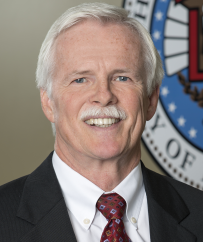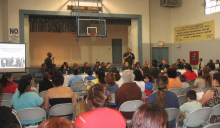10 years ago, the State of California created the Strategic Growth Council to encourage sustainable development, community revitalization, and advance climate and air quality goals. In January, the Strategic Growth Council awarded the largest grants in its history to three regions through its Transformative Climate Communities program: Fresno, Ontario, and Los Angeles. The Los Angeles winner was the Watts Rising Collaborative; the promise made: implementing a sustainable vision for new and more affordable housing at the Jordan Downs Urban Village. For context, Jordan Downs Housing Projects was —for more than half a century—a 700-unit public housing apartment complex in Watts consisting of 103 buildings with townhouse style units ranging from one bedroom to five bedrooms. Owned and managed by the Housing Authority of the City of Los Angeles (HACLA), the complex was built by the federal government in the mid-1940s, and was the first Veterans Housing Project in the country. HACLA CEO Doug Guthrie, a lead member of the collaborative team now tasked with master planning and transforming Jordan Downs recently sat down with TPR to elaborate on the Jordan Downs plans and build out, as well as the current state of federal support for affordable housing funding.

Doug Guthrie
“The Master Plan for the new Jordan Downs Urban Village calls for a total of 1,400 housing units accommodating a mix of incomes, as well as a retail center and a community center. We’re now in Phase 1A, and the first 115 units of housing are being built.” - Doug Guthrie, HACLA CEO
Doug Guthrie: First, we want to thank the Strategic Growth Council, not only for the award, but also for developing an interesting program that addresses environmental issues in low-income communities.
Jordan Downs is a public housing site in Watts, with 700 units on 50 acres of land. The Housing Authority has been working on redeveloping this site for a number of years. In 2008, we acquired a 20-acre industrial site extending into the middle of the community. Since that time, we’ve gone through a planning process, brought on development partners, completed environmental remediation, and secured funding. It has been a long and collaborative process, and we’re now at the point where construction is taking place.
The Master Plan for the new Jordan Downs Urban Village calls for a total of 1,400 housing units accommodating a mix of incomes, as well as a retail center and a community center. We’re now in Phase 1A, and the first 115 units of housing are being built. We’re also working on major infrastructure changes, including the extension of Century Boulevard through the village. Next month, we expect to close on the next 135 housing units and the 115,000 square-foot retail center.
It’s worth noting that when the opportunity first came to apply for the Transformative Climate Communities grant, our initial thought was only that it could fund the subsidy portion of the housing buildout. But as we looked at it, we saw that it provided a much broader opportunity to engage many Watts stakeholders in addressing our environmental concerns.
The TCC grant looks to reduce the carbon footprint of the entire community of Watts, not just Jordan Downs, and it looks for collaboration throughout the community. This was an opportunity for us to work with many of our known partners, as well as to discover new partners. We reached beyond what we would normally do to initiate this process, and it all came together.
Our development partners are BRIDGE Housing, which is a West Coast non-profit housing development group, and Michaels Development, a for-profit builder and one of the largest builders of affordable housing in the United States. Michaels Development played a big role in helping to coordinate and pull this grant together.
Out of the $35 million award, the Housing Authority is getting $13 million directly for the Jordan Downs redevelopment. Of that, $10 million will be a subsidy for housing development by Michaels, and $3 million will help build out the park system in the village. The balance of the funding will go to all the other partners and projects.
This project will bring positive changes to Watts, environmentally and otherwise. The redevelopment of Jordan Downs will serve as a catalyst for a community-led transformation of Watts.
Who are the other partners that compose the Jordan Downs team tasked with transforming the housing and infrastructure in this Watts neighborhood? What does each collaborating partner bring to the project?
We’re collaborating with more than 30 organizations on about 25 projects. For example, we’re working with Metro to convert the entire bus system in the community to electric, with 10 new all-electric buses. We’ll also have electric-car sharing programs, electric vanpools, and charging stations based out of the Jordan Downs shopping center. We’re working with the Watts Labor Community Action Committee, Green Commuter, and Primestor, the developer of our retail sites, to bring those transportation options to residents.
Additionally, Solarwatt will install rooftop solar panels and provide reroofing for 150 single-family homes. And with LAUSD, we’re working on an interesting project to bring community gardens to schools in the area. Markham Middle School, for example, is working on a “greentech garden” on campus. They’re building green technology and green jobs into their STEM curriculum. Students will learn how to grow food from seeds, and what they plant in these school-based parks will contribute to our overall goal of planting 4,200 trees throughout Watts.
With TreePeople and other partners, we’re building a tree canopy corridor and park space along the Metro Blue Line, near the 103rd Street station. We’re also building about three miles of bike trails through the community, as well as an urban art walk that will have interchangeable art along the way to the Watts Towers.
To me, the most exciting part of this project is having such a broad, community-based collaborative working together.
The Planning Report has covered attempts to rethink and redevelop Jordan Downs for nearly three decades. Share how the project has evolved over time, and how it speaks to the potential for other HACLA projects in need of reinvestment.
The Housing Authority was established in 1938. An issue facing us now is what to do with legacy developments like Jordan Downs: very large sites with 50- to 70-year-old buildings that have simply come to the end of their life cycles.
Meanwhile, public housing throughout the country is being dramatically challenged. The federal government has been walking away from the sector for a number of years. We get less funding every year for operations, and less capital to keep up our physical assets.
This means we have to find new and creative ways to rejuvenate communities, and to preserve the critical deeply affordable housing stock that cities like Los Angeles desperately need to protect—and to dramatically expand upon. These big legacy sites could be great assets to the community, if we can figure out how to transform them and bring them up to current and future standards. This is a long process, and it takes a lot of resources. It’s challenging—but not impossible.
An important part of our approach to envisioning the future of our communities is strong community engagement. This is a call for dramatic change, and change is hard for anybody—let alone for those who have fewer options because they live in impoverished areas. This type of work takes a long time, and collaboration with the community to build trust and transparency is a must.
Another component of our strategic approach is consideration for increasing density in larger sites, providing for a mixture of incomes, and providing opportunities for residents to access education, healthcare, and employment.
Are local and regional governments today capable of building affordable housing at scale—especially given the withdrawal of federal financial support?
It’s going to be very difficult. At the federal level, the Trump administration’s proposed budget would reduce funding for public housing by almost 50 percent, eliminate any capital dollars for public housing, and even reduce support for the Section 8 housing program.
In Los Angeles, around 150,000 people are housed through Section 8. It’s one of the nation’s largest rental subsidy programs. HACLA also runs the largest program in the country for homeless veterans, with 4,300 units. We own nearly 10,000 units and directly administer another 58,000, around 18,000 of which are committed to the homeless population.
How do you do all this without the money? Well, you can’t. That’s why we’re looking for more innovative ideas and local collaboration. The federal government is becoming less reliable, so we have to look for partnerships with the local and state government.
In California, the state is now stepping up, with significant legislation passed in the recent session and more to come. Los Angeles is addressing the outstanding problem of homelessness head-on: The city passed Measure HHH, which will provide $1.2 billion in funding over the next 10 years, and the county passed Measure H, which will provide $350 million per year for the next 10 years.
Los Angeles County has taken the creative approach of using healthcare dollars as a housing resource. The logic behind this is that chronically homeless individuals are frequent users of the healthcare system, so if they can be kept out of emergency rooms and hospitals through supportive services and permanent housing, then the county can save a lot of money.
But it was a big blow to the state of California when the governor decided to do away with redevelopment agencies. In Los Angeles alone, redevelopment brought in well over $50 million a year for affordable housing development opportunities.
In the state Legislature and in many city halls, there’s a growing drumbeat for increasing housing supply. HACLA is on the front lines of the finance side of housing supply and demand. Speak to the challenge of, for example, declining federal support for Section 8 vouchers.
We opened our Section 8 waiting list last fall for the first time in 13 years. It was open for 10 days, and we had 188,000 households apply during that window. We’ve estimated that as many as 600,000 households in the city of Los Angeles are eligible for the program, based on their income. The demand is just overwhelming, and the resources limited.
The Section 8 program does more than house people in privately owned apartment units. We use it for a variety of purposes. For example, the Section 8 program allows HACLA to be the third leg of the financing stool for permanent supportive housing. The first leg is the city, which is using HHH funding to provide gap financing to build the housing. The second leg is the county, which is providing supportive dollars for mental health services. Then we come in with project-based Section 8—a 15-year commitment to provide underlying operating support to that building.
These projects can’t be built if you can’t operate them, and that’s where Section 8 comes in. It’s a critical part of financing these projects. We’re committing 5,000 units of project-based Section 8 toward the buildout of permanent supportive housing over the next five years.
How are we able to make this commitment, despite potential funding cuts? Well, we regularly see turnover in our existing Section 8 portfolio from people moving out or passing away. Those vouchers are returned to us at a rate of approximately 200 per month. There are a lot of different ways we can use them, but we are choosing to direct a significant portion of them into the homeless housing initiative.
Section 8 is woven throughout the broader community here. And under the federal budget proposal, we could lose as many as 200,000 vouchers nationally.
To conclude, how could present and future housing policy debates be framed to better assist HACLA’s core mission?
Access to housing is a fundamental basis for everything we do. You can’t expect families or individuals to be successful in other aspects of their lives when they don’t have a stable place to live. Children are not able to focus on their education, and poor health outcomes are associated with lack of housing.
Clearly, we have an affordable housing crisis. We need to attack this issue on all fronts: federal, state, and local. As a community and a society, we need to figure out a way to increase access to housing for all people. All of our policies need to respect that, and to focus on it.
- Log in to post comments






